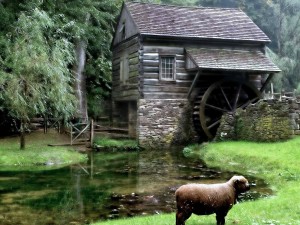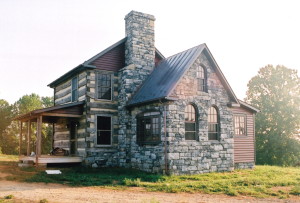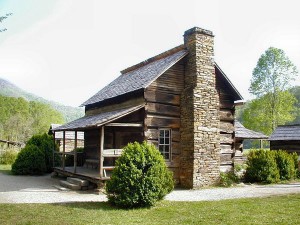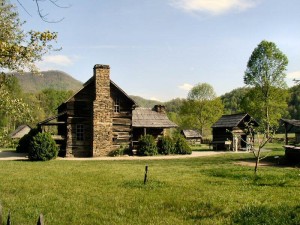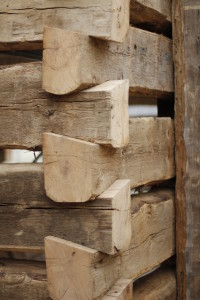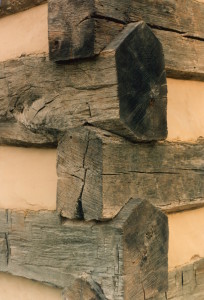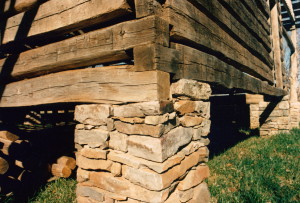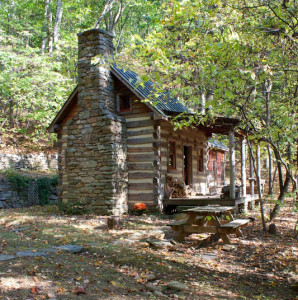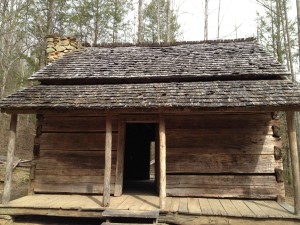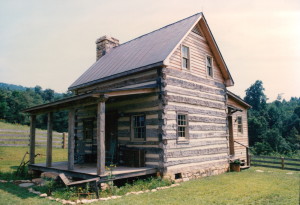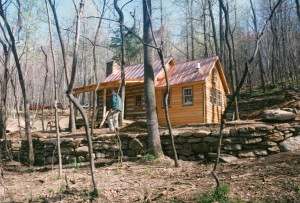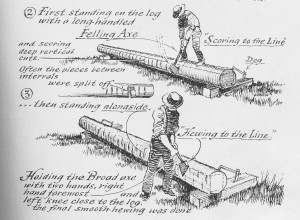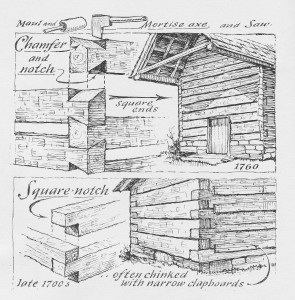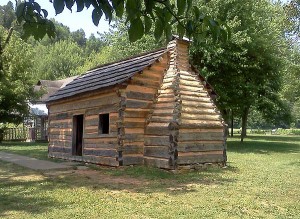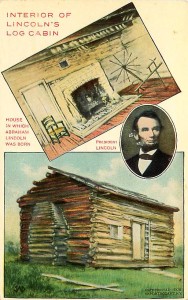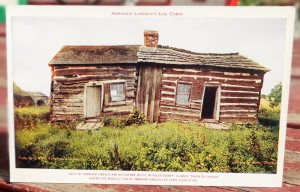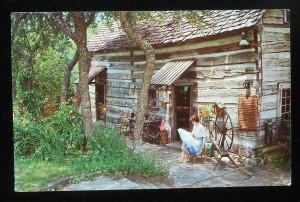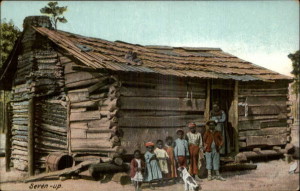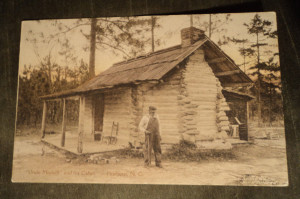Wood or Stone?
Noah Bradley2019-06-29T09:59:48+00:00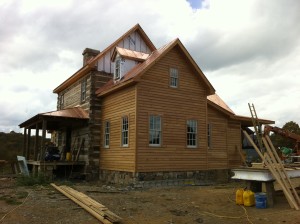
When it comes time to add on to your log home… will that addition be made of wood, or stone?
For many, if cost were the same for either, would choose stone. Without a doubt the stone is a more expensive option… in the short run. But over the coming decades, and even centuries, as the wood siding will need maintenance, repairs and even replacement, the stone will be there… forever.
But the wood should not be considered second rate by any means. There is a warmth and charm to wood. People who are drawn to log homes are also wood fanatics, they can’t get enough of it. And that is a good thing.
The choice is yours to make.
Which will you choose?
Originally posted 2015-08-16 13:41:08.
Log cabin notches… which is the best?
Noah Bradley2019-06-29T09:59:45+00:00There are three different types of corner notches on log cabins found here in the Mid-Atlantic states… the half-dovetail, the V-notch, and the square notch.
The half-dovetail and the V-notch are found on log homes and barns and even often on barns and other types of outbuildings. Whereas I have only seen the square notch used on supplemental farm buildings.
The half-dovetail, as seen above, I believe, is the most attractive of the three types of notches and offers the added benefit of ensuring that all of the rain that strikes the top of the notch drains out of the notch and to the exterior of the cabin. You would think it would be a difficult notch to make but I have found it easier to make than the V-notch and not much harder than the square notch.
The V-notch is perhaps slightly more common in old cabins. The top of each notch looks like a pointed roof of a house. I have heard some people refer to this notch as a saddle notch, but that name I reserve for the notch used out west where round logs are commonly used and thus rounded notches are created for them… which makes each notch look like a saddle. (I wouldn’t ever want to ride a horse with a saddle that was shaped like a pointed roof of a house)
And then finally, there is the square notch. A common choice among farmers wanting to get their barns up quickly and covered over with a large overhanging roof that would protect these notches from ever getting wet. The notches’ flat tops and bottoms invite rain in and don’t allow it drain out so rot would soon happen if left exposed to weather. These notches also offer no horizontal binding strength so each notch is “blind pegged” from above as each log is put in place. (blind pegged meaning that you don’t see the pegs)
So when it comes time to build your cabin… which notch will you use?
Originally posted 2015-08-13 13:37:07.
How to turn a tree into a log cabin
Noah Bradley2019-06-29T09:59:34+00:00Today, with the help of artist/writer Eric Sloane, I’d like to share with you the process of starting with a tree and then making a home out of it… with just a few basic tools… no manufacturing facility necessary!
There are two things about this drawing that I’d like to comment on…
One is that we have improved upon this antique version of a chalk line. This device marks the length of the log with a line that will be our guide in hewing the log (creating a flat surface on the inside and out). This diagram envisions this log to be hewn with an axe on all four sides which would create a floor joist (or ceiling beam).
My experience in working with old logs, and in performing this same technique today on fresh cut logs, is that rarely is the complete log de-barked. That’s a lot of work that will only be discarded by next phase of the work anyway. (I and most log workers of the past would just remove the bark where the line would be snapped)
The next step would be the axe work. First you stand on the log and cut away the wood at regular intervals down the length of the log, cutting back to your marked line with each finishing cut.
Then you go back down the length of the log with this same axe knocking out the chunks of wood left in between your knotches.
Next, you come back with a special axe… a broad axe… an axe with a large head and is beveled only on one side, which smooths the log down to the finish we see on old log cabins.
The process, for me at least, is labor intensive, but I have witnesses men who can swing an axe with more ease than a carpenter swings a hammer, men who could do this type of work all day long. It’s amazing to watch.
These hewn logs would then be used to create a log home or outbuilding.
Eric Sloane does an incredible job of displaying the beauty of a half dovetail notch doesn’t he? But the notches he drew on the second log corner, (which I would call a half-lap joint), must be a New England method of notching. Here in Virginia we have a square notch also, which is always used on outbuildings and barns, where the ends of the logs are squared and large pegs are driven down through each log end, once it is laid.
Another exception that I would take note of is that it appears the logs in this drawing have been all been hewn on all four sides, which I have never seen on any cabin. Maybe again, it’s a New England feature? I find that log cabins are much more attractive with the natural curves and unique shape of the original log. (this is a major failing in so many log cabin kits)
This sketch is from Eric Sloane’s book “Museum of Early American Tools” which is one the books on my recommended reading list that I offered a few weeks ago. I’d like to share a few more of Sloane’s sketches with you in the coming day or two… I think you’ll enjoy them.
BTW… I have four duplicate copies of four different books of Sloane’s (one that is out of print) that I’m giving away to four different people that sign up by Monday. I’m going to do a random drawing of those on the list… I’ll shoot the winners an email and ask for an address. … if you get my free list of the books I recommend reading you will be automatically signed up. Oh… one last thing… those that signed up to get the free guide prior to this last weekend, there was a technical issue… you did receive your guide, but you weren’t signed up… sorry about that… please, try again, thanks… I’m afraid that I am a much better builder than I am a techie. Noah
Originally posted 2015-08-07 14:35:19.
Lincoln’s log cabins
Noah Bradley2019-06-29T09:59:31+00:00Here is a replica of Abraham Lincoln’s childhood cabin where he spent most of his childhood, along with his parents and brother. This cabin is built on the site of the original cabin and as authentic to the original as it could be made.
Abraham Lincoln was born in the log cabin seen in the post card above, but his family moved a year or two later, so he had no memory of this first cabin in his life.
This birthplace cabin, according to the website that keeps track of all the cabins that Lincoln lived in, later “disappeared”.
Here is a log cabin that Lincoln built with his father. According to this post card it was taken down and moved for display at the Chicago Worlds Fair.
Originally posted 2015-08-05 13:08:37.
Some of the many benefits of living in a log cabin
Noah Bradley2019-06-29T09:59:30+00:00Families who live in log cabins are always happy.
The men where hats and smoke pipes.
All is well with the world.
Living in a log cabin instills peace in one’s soul, and often inspires creativity.
And living in a log cabin has long been known as a cure for infertility issues.
And finally… Log cabins were the original man cave.
Originally posted 2015-08-04 17:12:14.

